LFUCG HOUSING MARKET STUDY

RCLCO

Urban Collage

EHI Consultants

July 1, 2009



RCLCO

Urban Collage

EHI Consultants

July 1, 2009

The Housing Study has identified several key findings related to the provision of housing within Lexington-Fayette County:
The city’s regional share of housing, that is affordable to a broad cross-section of the market has been declining; There has been a net migration of households out of Fayette County to the surrounding counties; City residents spend a smaller portion of their income on housing than the national average. As a result, Lexington is comparatively affordable and attractive to in-migrants from other higher-cost parts of the country. That said, Lexington households with the most moderate incomes are paying a significantly higher share of their income on housing, a percentage more in line with the national average; There is a significant unmet demand for housing at the most affordable levels;
The relatively large percentage of students leads to a high demand for rental product and a corresponding higher percentage of renters versus owners;
Like most parts of the country, higher income housing has been overbuilt in recent years;
The city has an extremely diverse market audience which is reflected in widely divergent preferences in targeted consumer research. Within New Circle Road, there exists a greater appetite for higher density product and diverse communities where residents are motivated by proximity to work, walkable environment, and access to green space. Outside New Circle Road, stronger preferences exist for single-family homes and lower density development and residents are motivated by value in price as well as amount of space for their money;
Barriers to meeting evolving market demands include existing regulatory structures, the lack of financial subsidies for affordable housing, and the need for public investment in potential redevelopment areas; and Currently, the market lacks examples of key types of development that are present in other markets (e.g. traditional neighborhood development and variety of mixed-use projects) that would likely influence stated market preferences.
Nationally, large demographic shifts will significantly affect future housing demand. Based upon extensive research conducted by RCLCO and others, the following trends will affect future housing choice throughout the country and in Lexington.

Between 1985 and 2000, just over two-thirds of household growth was comprised of one- and two-person households, and the U.S. Census anticipates that nearly 90% of the household growth until 2025 may be comprised of one- and two-person households. According to U.S. Census data analyzed by the Brookings Institution, smaller households have demonstrated a preference for downtowns and other urban neighborhoods, where denser housing types typically predominate.
Much of this growth is being fueled by the aging baby boomers. As they become empty nesters and eventually retirees, their lifestyle and corresponding housing needs change. In Lexington, this will mean changing demand from existing households as well as potential influx of new residents, as a portion of baby boomers, more so than the previous generation, indicate they will choose “affinity locations” such as college towns for retirement.
Another major factor is Generation Y. This youngest cohort, the oldest of whom is turning 30 this year, is a larger group than their baby boomer parents and appears to have much more pronounced housing preferences. Their most preferred locations are downtowns and inner-ring suburbs; they value the ability to walk over almost all else; they seek diverse communities; and they value location and community over home. Within Gen Y there is still significant appetite for more suburban settings, the key being that they want the suburbs to be different – more walkable and with more variety of products.
Based on the growth in smaller households as well as growing preferences for high-density housing among all households, it is likely that the coming decades will be witness to increased overall demand for higher-density housing. Nationally, there may be as much as a 140% increase in demand for higher-density housing (over levels calculated by using the 2005 American Housing Survey distribution), approximately half of these units will likely be demanded in dense, mixed-use, walkable neighborhoods.
Sustainability is an important and increasingly critical motivation for the location and type of home in which people live. For approximately 40% of the market, purchasing a “green” home is a critical purchase motivation and living in sustainable communities is important to an even larger share of the market. “Green” is increasingly becoming mainstream and will likely be a major shift in the housing when the housing market recovers.
It is important to note that while RCLCO’s research and related research highlight a growing preference for high-density living arrangements, RCLCO’s data indicate that today traditional suburban-style development is still most preferred by almost 50% of potential homebuyers nationally and approximately 60% of the market locally.
These trends, among others, portend a change from historical demand patterns, both nationally and in Lexington. There will always be a portion of the market that seeks larger lot and lower density development. In all markets, there is almost always more demand than supply for this product. Perhaps not surprisingly, in Lexington-Fayette County the same is true of housing for first-time homebuyers and households with the most affordable incomes.
As discussed above, there will be more growth in demand, however, for lower maintenance housing product, due to growth in smaller households and an aging population. The result of our analysis of supply and demand for housing by income band and housing preferences suggests three primary areas the city should focus on:
1. Immediately address the shortage of housing, particularly quality housing, for those with the most moderate incomes;
2. Plan for longer term growth in demand for higher intensity product (condominiums, townhomes, and small lot single-family) in all areas within the urban services boundary (USB); and
3. Pursue regulatory changes and public investment that can encourage a broader range of higher intensity development in the form of welldesigned neighborhoods in order to accommodate the portion of the market that seeks this product and capture the highest share of the market that would consider it as a trade-off to lower their transportation costs.
Fayette County experienced strong population growth in the 1990s, adding over 3,500 people annually. The vast majority of growth was in the eastern and southern parts of the city, outside of New Circle Road. During the 1990s, the area inside New Circle Road actually lost 1,400 residents.
Most population forecasting sources estimate growth to have slowed in the 2000s to anywhere between 1,650 and 2,650 new residents annually. However, an analysis of permits completed by the LFUCG actually shows annual growth increasing this decade to 4,500 residents annually. Our review of the various estimates and secondary market data, suggests that growth has slowed somewhat this decade, however not as much as the most conservative estimates. We estimate that, on average, approximately 2,700 new residents have been added to the county each year this decade.
Going forward, RCLCO expects growth to pick up again beginning in 2010 with an improved national economy. Growth should average approximately 3,150 new residents annually in the coming decade before gradually slowing down after 2020 to an average of roughly 2,150 new residents annually.

Comparison of forecasts:

Lexington-Fayette County has a somewhat unique demographic make-up relative to the region. A few noteworthy characteristics, illustrated in more detail in the appendix, include:
A higher concentration of renters and younger households than the region. Both of these factors are heavily influenced by the presence of University of Kentucky;
A slightly higher concentration of one- and two-person households;
A “fair share” of moderate incomes (defined here as household with income below $35,000); and
To date, the county has been losing middle income market more so than households overall, primarily to Scott and Jessamine Counties.
As summarized in the consumer research, those who live within New Circle Road have fairly distinct attitudes and preferences about where and how they live. Respondents with interest in living inside New Circle Road prefer a more diverse community in terms of people and housing. Overall, respondents who prefer to live outside New Circle Road prefer a more conventional community and home themes.
In terms of housing product, those who want to live within New Circle Road are much more willing to make trade-offs.
71% would choose a home with smaller square footage and higher finish opposed to a larger home with lower level of finish;
66% would choose a home with a less than ideal floorplan but closer to work;
60% would choose a less than ideal floorplan but walkable to shops, restaurants, activities; and
66% want homes in more an ‘urban’ environment.
In terms of community features, respondents who have interest in living inside New Circle Road are very much driven by walkable features followed by interest in green features and public transportation. Those with no interest in living inside New Circle Road, have comparatively little interest in these community features.
Walkable:
41% of respondents with interest in living inside New Circle Road think walkable community features are so critical they would pay extra for it.
12% of respondents with no interest in New Circle Road agree.

Green:
26% of respondents with interest in living inside New Circle Road think green community features are so critical they would pay extra for it.
9% of respondents with no interest in New Circle Road agree.
Public Transportation:
19% of respondents with interest in living inside New Circle Road think public transportation community features are so critical they would pay extra for it.
4% of respondents with no interest in New Circle Road agree.
Fayette County is the job center for the greater Lexington region. As illustrated in slides 59 and 60, Fayette is home to the largest concentration of jobs (150,000 in 2006) and is one of only two counties with more jobs than households. With jobs to housing ratio of 1.4, there is a significant portion of the employees who work in the county and live outside. Slide 4 graphically depicts the commuting pattern of those working within the county.
Commuting from outside of the county is a choice many have made and continue to make for lifestyle reasons but is also increasingly an economic reality. The loss of product available on the market (both from new construction and turnover of existing homes each year) that is priced below $120,000 is sending more people to outlying counties. This is something of a natural evolution that occurs in many markets but also creates opportunities for development in the county to better respond to the market’s changing needs in the face of the available options.
As a result of economics, current regulations, and market preferences, Lexington-Fayette County has lost market share this decade. In 2000, Fayette accounted for 57% of all households in the region while in 2008 it is estimated to have accounted for 55% of households. While the 2% drop may not seem remarkable at first blush, it translates to the county capturing 38% of regional household growth compared to a 57% “fair share”. Counties that have been capturing more than their “fair share” of household growth include Scott, Madison, and Jessamine.
Even in a down housing market with a significant excess of total inventory, supply has been and continues to be constrained for product targeting first-time buyers and those with more moderate incomes. As illustrated in the attached, slides 55 and 56, there is much more limited inventory for all homes in Lexington as compared to other counties and particularly for homes priced below $160,000. Over the years, supply below $140,000 has diminished precipitously. In a market where the median owner-occupied home is $145,000, this creates a challenge for approximately half of the market.
RCLCO’s statistical demand analysis of the for-sale market substantiates the shortage of for-sale product below $85,000. Further, as the market for product priced $85,000 to $133,000 is in balance, we recommend revisiting the supply/ demand dynamic in this price band going forward. To date, Lexington has not experienced the significant drop-off in home pricing as experienced in other more overheated markets. As illustrated in slide 52, home pricing in Lexington ran fairly linear to the nation overall until 2000. After 2000, homes in the nation appreciated at a much faster rate than the local market and although Lexington climbed slightly faster this decade than the previous decade, the run-up was much more moderate than the nation. As such, Lexington has had comparatively little to “give back”. All of this is to say that the softening in the housing market and the economic downturn will not likely solve the affordable housing problem in Lexington.

Based on our review of household growth forecasts, secondary market data, and historic home sales data, we quantified rental and for-sale demand in Lexington-Fayette County by income band. Our methodology for this top line analysis includes looking at current residents (renters and owner) as well as projected new households to the county. All groups were qualified by income and corresponding affordability, turnover rates, and likelihood of becoming renters or owners again. This analysis does not include segmenting the market by geographic preference or by product type.
The results of the for-sale housing statistical demand analysis (summarized below), reveal that the for-sale market is generally in balance for product priced between $85,000 to $244,000, over-supplied with product priced above $244,000, and grossly under-supplied with for-sale product priced below $85,000. Going forward, economic downturn not withstanding, there is a high probability the market will become under-supplied with homes priced $85,000 to $133,000 as new product at these price points can be difficult to deliver. This price band should be monitored and policy should be crafted to facilitate the delivery of such product.
1 Demand methodology is to assess structural demand and is based on Census and Claritas data related to tenure, turnover, and affordability for households in Fayette County. This represents an annual average for the next five years assuming rational market behavior. This type of statistical demand should be used as a guide for mid-term planning as it does not account for the contraction in demand over the next 12 months.
It is important to note that all areas of the county are not experiencing the gap in supply equally. All subareas are undersupplied of for-sale products below $85k. However2:
Inside New Circle Road
Generally under-supplied across all price bands.
76% of new product delivered and sold inside New Circle Road since 2004 has been below $270,000 revealing that despite rising land prices, it is still possible to deliver products at middle market prices at closer-in locations.
North
Of all the sub-areas, appears to have the best supply and demand relationship.
Northwest
Residents currently indicate the least level of preference for this area. However, land availability has meant that Northwest has been the recipient of new supply that has been unable to be delivered in more desirable areas.
South
Southwest
East
Despite relatively healthy supply of product below $120,000 this area suffers from a dramatic supply/demand imbalance at lower price points.
Supply/demand imbalance at lower prices points is moving into higher price bands.
Most significant oversupply of higher priced homes in this area.

Like most urban areas, Lexington-Fayette already has an affordable housing problem. Developing precise numbers for the market overall is challenging due to the large student population, their transient nature, and the difficulty associated with determining whether or not students are being counted evenly in secondary data. That said, the statistical analysis discussed below utilized all of the data available to combine statistical with judgment to reach our best estimates.
Our statistical analysis of supply relative to demand reveals significant challenges in the rental housing market. As illustrated below, statistically, Lexington-Fayette has a significant deficit of rental apartments priced below $500 monthly. Further, middle income renters are paying a lower percentage
2 A map illustrating the submarket can be found on Slide 2.
of their income on rent than is typical, placing more pressure on these most affordable rental ranges. The lack of product in these price bands is putting pressure on the single-family rental market, effectively creating a market for single-family homes to become rental. On the other end of the spectrum, there appears to be a longer term opportunity to introduce lifestyle rental product into the market. Statistically, there is an under-supply of higher end rental product. Effectively, this means that higher income renters are “renting down” but when the economy recovers and with the right community types, there appears to be an untapped market for higher end rental.
In the context of limited supply, a significant portion of the market is making trade-offs to accommodate their preferred lifestyle. Some move further out to find the housing product they want while others choose to rent or buy a “less than ideal” home in a convenient location.
This diminished supply at the most affordable price bands and the outward development pattern is not unique to Lexington and is consistent with general market preferences. Across the United States the majority of the market has made a choice to “drive for value” or “drive until they qualify”. Sixty percent of Fayette County employees say they have the same preference.
We should not ignore that 40% say of the market prefers a close-in location and, based on the experience in other market and with broader macro trends, the 40% figure will likely grow. The most effective ways to accommodate more of the 60% drive for value market inside the USB (a shift that would have a positive impact on transportation and the environment) is through:
Small lot SFD product – 41% of the market would accept a small lot inside New Circle Road if it lowered their transportation costs.
Attached (townhome and condominium) product – 28% of the market would accept an attached home inside New Circle Road in order to lower their transportation costs.
There is already a fairly large small lot single-family detached market. Twenty-five percent of the market states that it is their preferred home type. To date, much of the small lot product in Lexington serves the starter market. Although there are several examples of higher-end small lot product, there appears to be a void of small lot product with great design across price points. The key to accommodating the market in smaller lot product across price bands is through great community and home design.

Case studies from other markets reveal that an even larger share of the market (than the 25% and even the 41%) will accept small-lot product in the context of great neighborhood design. Once the market can literally see, touch, and feel high quality streets and the convenience of the lifestyle, a much larger share of the market prefers and accepts smaller lot product, particularly among key market audiences and income levels.
Based on the stated preferences of the existing market and assuming new growth will be accommodated in a context of trade-offs, we estimate demand for 4,700 to 4,800 new, small-lot single family homes through 2030. This analysis does not account for any dramatic change in transportation costs, nor does it account for the introduction of new transportation alternatives, both of which could impact these figures.
Examples of communities that have effectively incorporated small-lot product into high quality, successful mixed-use communities are summarized on the following page.
Insert #1

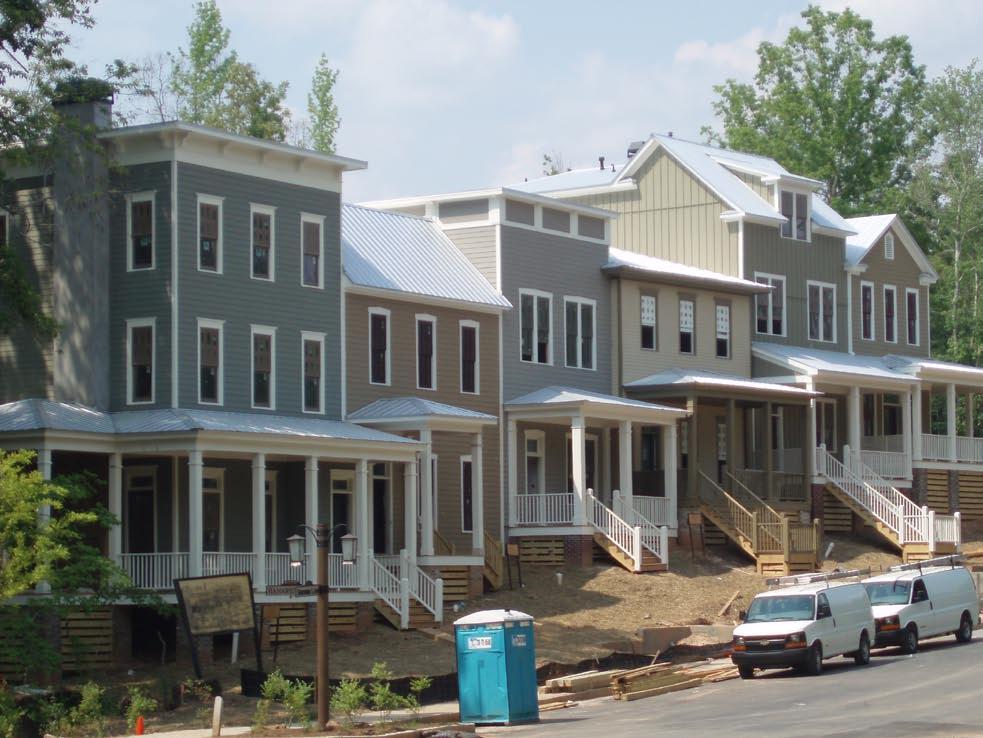
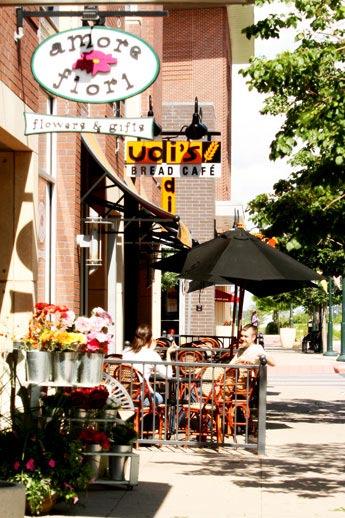

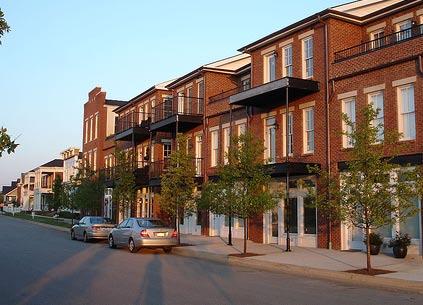


Birkdale Village is a 52 acre mixed use development that includes dining, commercial, and residential uses. The majority of residential space is in 1-3 bedroom apartments above ground level retail all of which are surrounded by community amenities such as the town green which creates an urban pedestrian friendly environment.

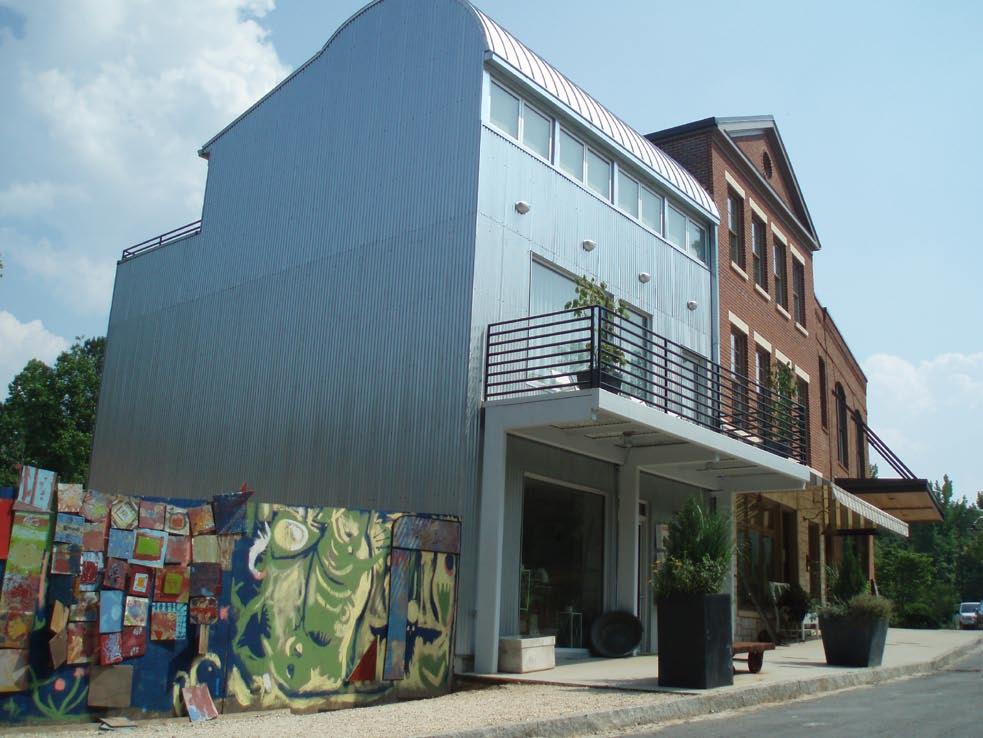

10-15 du/acre
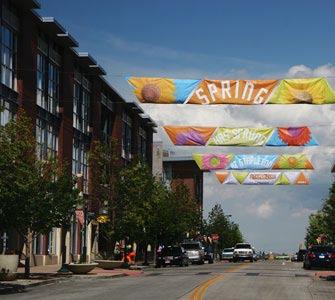
Norton Comm ons is a 595 acre Traditional Neighborhood Development (TND) that includes a mixed use “Village Center”, single-family detached and some attached homes in the “V illage General”, as well as a “Village General” which is comprised of mostly single family detached homes. The site also offers an abundance of greenspace as well as co mmunity gardens.
10-15 du/acre

Serenbe is made up of a 900 acre area outside of Atlanta, Ga. Serenbe is devoted to bein g a sustainable development both environmentally and socially. The site has been designed and planned in an environmentally friendly way in an attempt to provide residents with the necessities of a community while lessening their impact on the surrounding environment.
20-30 du/acre
Stapleton is a mixed use district that includes f ive neighborhoods of differing housing types and densit ies . The district also includes schools that provide the area with educational opportunities. The neighborhoods are intertwined with parks commercial/retail opportunities in an attempt to make Stapleton a self sustaining community.
Glenwood Park is a mixed use development with a broad range of housing types including; townhouses, condos and singlefamily. Glenwood offers retail and office space throu ghout and stri ves to provide its residents with a walkable and environmentally considerate living space.
Attached housing has historically been a small share of the market. From 1998 through 2005, 7 to 14 percent of all of all home sales have been condominium or townhome product. As illustrated in slide 5, the share of the market that was attached experienced an uptick in 2006 (23% attached) and 2007 (29% attached) as the availability of mortgages and capital brought new buyers to the market - students, second home buyers, and some first-time buyers who otherwise may have remained renters. New projects also tapped into what was likely pent-up demand for such product. RCLCO consumer research reveals that 15.5% of the market wants and up to 23% of market will accept attached housing if they get another benefit in return (such as lower transportation costs)
Demographic shifts, particularly growth of one- and two-person households and an aging population, will create incremental shifts in demand for attached product that translate to a significant change in the number of new attached units through 2030.
Through 2030, we estimate demand for 5,500 to 6,000 new, owner-occupied attached homes. It is important to note that although much of this demand will be accommodated in the urban core areas, there is demand for attached product throughout the urban services boundary, particularly for townhomes. When you add to this an estimated total demand for 8,800 to 9,000 new attached rental units, total net new demand for higher density product (rental and for-sale) is approaching 15,000 units. These figures do not account for obsolescence of existing product and the likely need of the coming 20 to 30 years to replace some aging higher density housing stock.
An important component in demand for lower maintenance product is the aging of the baby boomers. With the oldest of the baby boomers approaching 65, many are already empty nesters and are looking toward retirement. With a delayed retirement compared to previous generations (an existing trend that will likely be magnified in light of the economic downturn), the peak of the baby boomers retiring will likely occur between 2020 and 2025.
A significant portion of demand for small-lot single-family, condominiums, and townhomes will come from these more mature households. Local projections call for 136% growth (more than doubling) in population aged 60 – 85 between 2008 and 3030. Increasingly over time, the market will need to respond to the needs of this aging population. Product types in demand will include:
Low to no maintenance single-family homes with master on the main;
Townhomes with master on the main in more urban areas as well as within existing single-family neighborhoods – the vast majority of empty nesters want to stay in their same neighborhoods so they c an go to the same grocery store, gym, church/ synagogue, etc.;
Flats located in service-rich locations;

Quad ranches in more suburban locations; and
In the longer term, independent and assisted living.
Within the demand for attached housing, there is fairly significant demand for new student housing. Currently, an estimated 6,000 units in the of-campus market are filled with students. This represents approximately 22% of annual rental housing demand. In terms of product type, more students (41%) seek a unit to share with one other roommate, followed by those (32%) who would prefer to live with two or more roommates. The least desired product,
perhaps due to expense, is a single unit; 27% of students indicated a single as their first choice. Based on input from University of Kentucky, we are assuming a need of an additional 400 beds off-campus annually. Given the reported preferences above, this would translate to 250 to 275 units of students housing.
Another intuitive yet important finding from the consumer research is the students want to live close to campus. Despite their being located throughout the county (Slide 12), their highest preference is to live in the subareas closest to campus. From a planning perspective, this raises some points for discussion.
Throughout the country and in Lexington, rental housing tends to concentrate, much more so than for-sale housing, near the central business district. With University of Kentucky being located intown, rental product is even more concentrated close in. In many ways this is desirable for transportation related issues but it also places pressure on the single-fa mily neighborhoods. High home ownership rates are typically associated with higher neighborhood stability. The converse is not always true but when the ratio between owners and renters is the opposite of a region (i.e. an area becomes 70% rental), there can be challenges associated with the more transient nature of rental properties.
Much of this demand can be accommodated through underutilized properties as well as though new mixed-use developments. The cha rt below quantifies the potential to redevelop underutilized properties with a full range of densities, the land for which was indentified in a survey of vacant land and unoccupied structures conducted by the Division of Planning in 2007. It is worth noting that here Medium Density Residential (approximately 7,000 total units) is at 4 units to the acre which is slightly lower density than is typically seen with small lot product. As detailed below, high and Very High Density Residential totals approximately 5,000 units.


In addition to or concurrent with redevelopment, there are areas throughout the market that would likely be appropriate for a full range for mixed-use development patterns. The table below highlights the significant amount of acreage that is potentially available for such development. The areas are illustrated graphically in the attached appendix.
(Insert


(Acreages are approximate measurements)
Much of the feedback from the consumer research is static and does not necessarily account for the dynamic nature of real estate and underlying economic trends. Outside factors must be taken into consideration when thinking about land use and affordable housing policy. They include, but are not limited to:
Land availability (greenfield and redevelopment opportunities) by subarea; Changing character of areas in the county that may influence market perceptions; Changing lifestyle needs and preferences with age; and Changing transportation costs and/or available income for transportation.
Based on all of the above and the team’s knowledge of the factors and trends above, we recommend the county pursue the following:
Targeted affordable housing strategies; and Regulatory changes to accommodate market demand for higher dens ity product across price points and accommodate the growing share of the market that seeks high quality, walkable, diverse, mixed-use environments.

With mounting foreclosures and tightening of the housing credit market, there has been a spike in the demand for additional rental housing and especially affordable rental units and the demand for affordable ownership is also on the increase. If current trends continue, today’s default crisis will soon turn into an even larger affordability crisis driven by the residents being locked out the ability for home ownership or even more critical access to affordable housing. The market analysis, which may not fully account for the impact of the foreclosure crisis, bears out the need to expand the supply of affordable housing units within the community and the region as a whole.
Innovative strategies of mixed-use neighborhood and infill development will be needed to increase the production and preservation of affordable housing. With the increase in the number of vacant and abandoned properties within Fayette County, a more robust effort by local, state and federal governments will be needed to address the affordable housing crisis faced by Fayette County. Some key strategies to pursue include:
Land banking is the process or policy by which LFUCG acquires vacant, abandoned or surplus properties and converts them to productive use or can hold them for long term strategic affordable housing purposes. Turning vacant and abandoned properties into community assets will foster a targeted and sustainable strategy of affordable housing preservation.
The Lexington-Fayette Urban County Government has proposed an application for Neighborhood Stabilization Program funds for the establishment of a land bank for the purchase of Fayette County foreclosed homes. A majority of these homes exist within identified low and moderate income neighborhoods.
Under the Land Bank, these properties will be purchased and ‘land-banked’ and then made available for developers to utilize for redevelopment (new construction or rehabilitation) and sale to low-income, moderate-income and middle income households for owner/occupancy. Federal funds will be used to support the cost of acquisition, appraisals, closing costs, relocation, if necessary and maintenance of properties while held by the LFUCG. After redevelopment, these properties are to be sold for homeownership opportunities for households whose incomes exist at or below 120% of median. The LFUCG is in the process of forming a land bank authority and once this authority is established, it will undertake responsibility for purchase and disposition of NSP-funded properties.
Under this proposal, homebuyers will be eligible at the time of final sale for subsidies under the HOME Investment Partnerships Program. Whether or not a HOME subsidy is provided, final homebuyers of NSP-assisted land bank properties will enter into mortgages, notes, and deed restrictions that enforce an affordability period that is consistent with HOME regulations and that require the unit(s) remain the buyers principal residence for a given length of time.
With the proposed Newtown Pike Extension, the Southend Park Neighborhood is being relocated as a vital part of this project. A guiding principle of the Southend Park Neighborhood is to provide affordable housing to all residents. Given this principle of affordable housing, the Community Land Trust (CLT) model was selected to meet the housing and development needs for this neighborhood. Under the CLT model, affordability is maintained by separating the ownership of the land from the home. This means the CLT retains ownership of the land while the homebuyer buys and owns the home and the CLT leases the land to the homeowner.
A steering committee has established by-laws and re-sale formulas as well as appointed a Board of Directors for the Lexington CLT. The CLT is a private, nonprofit 501(c)(3) organization that exists to preserve affordable housing forever as well as to assist and support homeowners and renters within the CLT properties and also to protect community assets. The goals and objectives of the CLT are currently being formulated by the Board of Directors.

The Bluegrass-Aspendale HOPE VI affordable housing project is a multi phase project currently underway with phases of multifamily and homeownership planned, overall the project will consist of 491 new units, including 260 subsidized rental units and 103 affordable and market rate single family units on the existing public housing site’s footprint.
The New Markets Tax Credits (NMTC): is a federal program that permits taxpayers to receive credit against Federal income taxes for making qualified equity investments. The purpose of the credit is to stimulate increased investment and economic growth in low- income communities. The NMTC stimulates investments in commercial real estate and business venture in low-income rural and urban areas. The Tax credits can be used to finance community development projects, but not in conjunction with projects already benefiting from other federal tax subsidies. The credit is provided to the investor over a seven year allowance period. Compliance is mandatory for seven years. Lexington needs to be more active in lobbying for these funds for projects in the community.
Low Income Tax Credits: The Federal Low-Income Housing Tax Credit program is run by the IRS and allows companies to invest in low-income housing, while receiving 10 years of tax credits. The program is administered by the Kentucky Housing Corporation. Many local housing and community development agencies have effectively used these tax credits to raise equity for developments that otherwise would not have been built or purchased and rehabilitated. The purpose of the tax credit is to increase the supply and availability of low-income rental housing by offering incentives to developers. Federal Low Income Housing Tax Credits enable property owners to claim a tax credit equal to 30% or 70% of a project’s present value, depending on the type of project. The tax credit is claimed over a period of 10 years and can be realized either through the sale of tax-exempt bonds or through an allocation from the Kentucky Housing Corporation.
Within the Fayette County affordable housing community there are several nonprofit housing providers that are charged with addressing the demand for affordable housing. Those entities include:
1. Community Ventures Corporation
2. Faith Community Housing Foundation
3. REACH
4. Lexington Housing Authority
5. Lexington CLT

6. Fayette County Local Development Corporation
The East End Small Area Plan recommends the creation of a Community Development Corporation (CDC) to ensure the revitalization of the neighborhood. A Community Development Corporation as a 501(c)3 non-profit corporation could be used to implement and coordinate an affordable housing strategy for the East End Neighborhood.
The CDC’s primary focus and priority would be to improve the East End Neighborhood holistically. This can be accomplished by establishing many programs that would constitute the core focus of the CDC. These programs include an Economic Development program, a Real Estate Development program, a Community Organizing program, an Infrastructure program, a Quality of Life program, a Housing program and a Community Arts program. Through the creation of the CDC and many of its programs, the revitalization of the East End would move towards becoming a reality.
Much of the regulatory changes required to accommodate market demand, in terms of types both of communities and product types, are consistent with those identified in the Infill & Redevelopment Steering Committee Report issued in March of 2008. To recap, various areas for types of scales of infill and mixed-use development were identified and in order to bring to fruition a broad range of issues need to be addressed, including those related to design and administrative processes:
Design issues relate to the character the market seeks: Site Design Standards: In priority Centers, LFUCG should create and institutionalize a set of Site Design Standards that encourage pedestrian-oriented development.
Transitional Requirements: Within the transitional areas between Centers and Corridors and Neighborhoods, LFUCG should establish standards that mandate minimum buffers, create transitional height planes and establish compatibility with surrounding neighborhoods.
Signage Standards: In areas of commercial and mixed use redevelopment, unified private signage of a common vocabulary and standardized location and size could be encouraged and billboards could be eliminated or minimized. Implementation of the previously adopted ordinance on amortization of non-conforming signs should be reconsidered by LFUCG.
Streetscape Standards: As part of the development of “Complete Streets Standards,” LFUCG should develop guidelines for adequate planting strips, street furnishings, landscape species and hardscape materials.
Parks and Open Space Standards: LFUCG should update and implement quantifiable standards for the provision of parks and open spaces. Standards should address locational frequency, public accessibility, and program for new and improved parks and open space.

As there are no stand-alone Mixed Use categories in the code right now (although there are Mixed Use classifications that properties can be rezoned to), the city needs to explore creating new mixed-use districts or overlays that are more form-based in their approach and provide architectural guidelines and then apply them to target areas to encourage redevelopment and pr ovide some context for remaining infill and greenfield development.
Additional strategies and approaches to address the issues and respond to market demand will be included based on input from the Steering Committee.
Our conclusions are based on our analysis of the information available from our own sources and from the client as of the date of this report. We assume that the information is correct, complete, and reliable.
We made certain assumptions about the future performance of the global, national, and local economy and real estate market, and on other factors similarly outside either our control or that of the client. We analyzed trends and the information available to us in drawing these conclusions. However, given the fluid and dynamic nature of the economy and real estate markets, as well as the uncertainty surrounding particularly the near-term future, it is critical to monitor the economy and markets continuously and to revisit the aforementioned conclusions periodically to ensure that they stand the test of time.
We assume that the economy and real estate markets are close to bottoming out for the current cycle, and that they will grow at a stable and moderate rate starting in 2010, more or less in a straight line on average for the duration of the analysis period (to 2020 and beyond). However, history tells us that stable and moderate growth patterns are not sustainable over extended periods of time, and that the economy is cyclical and that the real estate markets are typically highly sensitive to business cycles. Further, it is very difficult to predict when the current economic and real estate downturns will end, and what will be the shape and pace of growth once they are recovered.
With the above in mind, we assume that the long term average absorption rates and price changes will be as projected, realizing that most of the time performance will be either above or below said average rates.
Our analysis does not take into account the potential impact of future economic shocks on the national and/or local economy, and does not necessarily account for the potential benefits from major "booms,” if and when they occur. Similarly, the analysis does not necessarily reflect the residual impact on the real estate market and the competitive environment of such a shock or boom. Also, it is important to note that it is difficult to predict changing consumer and market psychology.
For all the reasons outlined , we recommend the close monitoring of the economy and the marketplace, and updating this analysis as appropriate. Further, the project and investment economics should be “stress tested” to ensure that potential fluctuations in revenue and cost assumptions resulting from alternative scenarios regarding the economy and real estate market conditions will not cause failure.
In addition, we assume that once the current cycle is over, the following will occur in accordance with current expectations:
• Economic, employment, and household growth.
• Other forecasts of trends and demographic and economic patterns, including consumer confidence levels.
• The cost of development and construction.
• Tax laws (i.e., property and income tax rates, deductibility of mortgage interest, and so forth).

• The availability and cost of capital and mortgage financing for real estate developers, owners and buyers, at levels present in the market before the most recent run up (i.e., early 2000s levels).
• Competitive projects will be developed as planned (active and future) and that a reasonable stream of supply offerings will satisfy real estate demand.
• Major public works projects occur and are completed as planned.
Should any of the above change, this analysis should probably be updated, with the conclusions reviewed accordingly (and possibly revised).
Reasonable efforts have been made to ensure that the data contained in this study reflect accurate and timely information and are believed to be reliable. This study is based on estimates, assumptions, and other information developed by RCLCO from its independent research effort, general knowledge of the industry, and consultations with the client and its representatives. No responsibility is assumed for inaccuracies in reporting by the client, its agent, and representatives or in any other data source used in preparing or presenting this study. This report is based on information that to our knowledge was current as of the date of this report, and RCLCO has not under taken any update of its research effort since such date.
Our report may contain prospective financial information, estimates, or opinions that represent our view of reasonable expectations at a particular time, but such information, estimates, or opinions are not offered as predictions or assurances that a particular level of income or profit will be achieved, that particular events will occur, or that a particular price will be offered or accepted. Actual results achieved during the period covered by our prospective financial analysis may vary from those described in our report, and the variations may be material. Therefore, no warranty or representation is made by RCLCO that any of the projected values or results contained in this study will be achieved.
Possession of this study does not carry with it the right of publication thereof or to use the name of "Robert Charles Lesser & Co." or "RCLCO" in any manner without first obtaining the prior written consent of RCLCO. No abstracting, excerpting, or summarization of this study may be made without first obtaining the prior written consent of RCLCO. This report is not to be used in conjunction with any public or private offering of securities or other similar purpose where it may be relied upon to any degree by any person other than the client without first obtaining the prior written consent of RCLCO. This study may not be used for any purpose other than that for which it is prepared or for which prior written consent has first been obtained from RCLCO.

Immediately address the shortage of housing, particularly quality housing, for those with the most moderate incomes;
Existing deficit of ~2,500 affordable rental units
Growing deficit of for-sale product priced below $120,000 Losing market share of middle market, family market
Plan for longer term growth in demand for higher intensity product (condominiums, townhomes, and small lot single-family) in all areas within the urban services boundary (USB). Market demand through 2030 for:
5,500 to 6,000 net new condos and townhomes
4,700 to 4,800 net new, small-lot single-family
8,800 to 9,000 net new rental apartments/ lofts/ units
Pursue regulatory changesand public investment that can encourage a broader range of higher intensity development in the form of well-designed neighborhoods in order to accommodate the portion of the market that seeks this product and capture the highest share of the market that would consider it as a trade-off to lower their transportation costs.




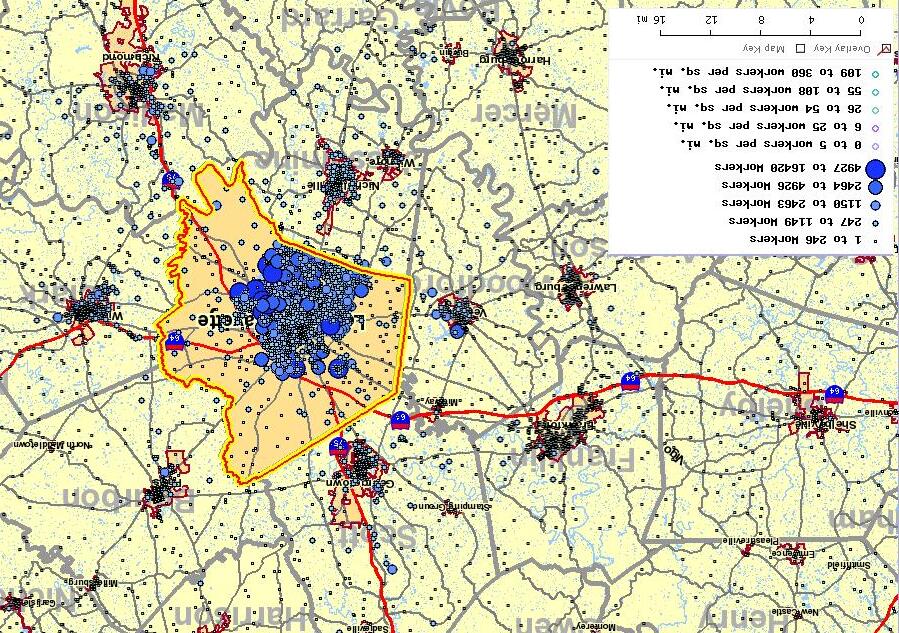




LARGEST OVERALL DEMAND FOR HOMES ON ¼TO ½ACRE LOTS
OPPORTUNITIES EXIST FOR VARIOUS PRODUCTS ACROSS



Includes demand for student rental housing

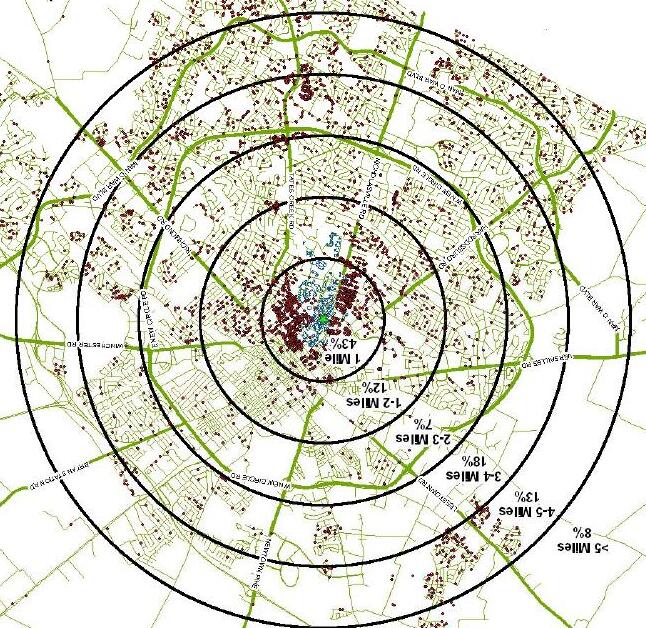
Source: LFUCG Planning and UK Facilities Management


Estimated distribution of renters actively seeking a rental unitannually
22%

75%
3% Students Existing Renters New Renters
Based on RCLCO Consumer Research and data from US Census Accounts for total off-campus units, as apposed to beds, sought by students (approximately 6,000) annually.
Potential Market Audience
Most Prevalent Cohorts
CURRENT RESIDENTS
•Families
•Empty-nesters
•Retirees
•Singles / Couples
EMPLOYMENT BASED GROWTH
•Families
•Singles / Couples
Location / Product Preferences Motivations
•Location: distance to employment cores and retail services
•Schools
•Proximity to cultural amenities
•Families –Suburban SFD
•Empty-nesters /Retirees & Singles / Couples–
increasingly seeking lower maintenance products & locations
Annual New Home Demand Potential
For-Sale: $100K+
For-Rent: $500/mth+
For-Sale: 1,500
For-Rent: 555
•Location: distance to employment cores and retail services
•Schools
•Singles / Couples
•Location: distance to campus
•Price
•Will weigh options throughout the region, may make tradeoffs to be closer to work
For-Sale: 200

For-Rent: 25
•Nationwide research indicates that they will seek active, walkable locations
400 Beds

In 2007, the Planning Commission did not approve any expansion of the Urban Service Area.

Growing community interest in exploring greater utilization of innovative techniques to encourage growth through urban infill and redevelopment as opposed to suburban edge development.
The LFUCG wishes to analyze short and longer-term housing market needs and opportunities in order to effectively plan and strategize to accommodate housing needs in an innovative, creative, and sustainable manner.
The LFUCG wishes to utilize this information to make informed decisions on neighborhood plans, regulatory techniques, affordable housing initiatives and to ensure that the techniques work in concert to the greatest degree possible with the anticipated market needs.
Thorough community understanding of current and future residential markets.

Assessment of current and future housing market in relation to projected employment and income levels; demographic trends; broad industrytrends.
Identification of market opportunities or needs potentially constrained by current policy or regulatory practices.
A thorough understanding of the residential market for buyers and renters of all incomes, and particularly those households who make below 80% AMI (Area Median Income).
Recognition of approaches that can be utilized to attract and/oreducate developers of residential housing product demand based on the market and the community’s desire to maximize livable, sustainable, residential density.
Understanding of the market needs as they relate to the larger regional context, including the adjoining counties and Bluegrass Region.

Phase One: Existing Market Conditions
Primary research and interviews with those active in the market
Detailed demographic and economic analysis
Submarket definition
Phase Two: Housing Demand and Market Opportunities Analysis
Supply-side analysis based on permits and home sales, by price band
Assessment of macro trend influencing housing demand and needs
Statistical demand analysis based on demographic and economic trends
Direct consumer research to understand preferences, trade-offs, and perceptions as an overlay to statistical analysis
Phase Three: Identification of Housing Needs and Affordable Housing Strategies
Affordable housing is immediate need
Greater diversity of housing densities and community types required for long-term sustainability
Housing to accommodate aging population required to respond to market

MULTIFAMILY
OFFICE RESORT
RETAIL
Bullish excesses pave the way to bearish corrections. Exuberance
RESIDENTIAL (FOR-SALE)
LAND


National Outlook
Recovery begins late 2009, early 2010;
“Close-in”areas to recover first; Inventory created through foreclosures (peak mid-2009) and over-building are greatest challenges;
• Success of Federal programs and investors clearing out standing inventory are key to timing of market recovery
Lexington Context
Run-up in price was not the problem. Price index reflects “steady state”opposed to national spike;
Over-building at the high end (above $400k and particularly above $800k) was part of the problem, still resolving today
Fayette County positioned to be the first to recover in region
Jobs are key to recovery
LEXINGTON, LIKE THE NATION, IS LIKELY TO SEE SLOW JOB GROWTH IN THE NEXT FEW YEARS, BUT IS EXPECTED TO RECOVER QUICKLY
HISTORIC AND PROJECTED EMPLOYMENT GROWTH
Lexington MSA
SOURCE:Economy.com




What demographic segments are growing and how do their preference differ from the products offered?
What locations are the most highly valued by the key demographic segments?
How do the demographic segments and where they are in their lifestyle intersect with each land use, i.e. rental apartments?
Use this time to make great decisions about how and where we develop
Anticipate the market and plan for changing preferences
Be ready for the “right”market audiences when the market recovers


United States, 2000–2006
SOURCE:U.S. Census Bureau


Emergence and Maturation of Gen Y = apartments, first-time buyers, first move-up buyers
Smaller Gen X demographic replacing Baby Boomers
Boomers are Major Influence = move-down/downsizing and lifestyle product
Senior Living
SOURCE:U.S. Census Bureau
Then: seniors moved to retirement communities; golf and community center focal points
Now: The community center became a village center; purchasing alifestyle
• Boomers seek “third places”like Starbucks, Barnes & Noble, and Borders as their “community centers”

portion
As boomers age will seek communities that facilitate:
• Learning and Education

• Making new friends and enjoying an active social life
• Being close to essential services
• Low-maintenance property that frees them to travel, socialize and pursue new interests

• Amenities that support them in their refusal to truly “let go”
Source: National Association of Realtors, Smart Growth America 2004





Aging boomer preferences are more easily addressed in smart growth than conventional subdivision design
• 11% of retiring suburbanites currently relocating to urban locations
– Even if most don’t relocate, many are seeking “urban amenities”in suburban locations
Communities with live/work/learn/play access because of where they are, or as an added amenity
Village or Town Center
• Amenities for convenience, healthy living, and staying engaged
Source: National Association of Realtors, Smart Growth America 2004





Driven by convenience, connectivity, and a healthy work-life balance to maintain relationships

1/3 will pay more to walk to shops, work, and entertainment
2/3 say that living in a walkable community is important
Even among families with children, onethird or more are willing to trade lot size and “ideal”homes for walkable, diverse communities
Even in the suburbs the majority of Gen Y prefer characteristics of urban places, particularly walkable environments
SOURCE: RCLCO consumer research
Family Changes:
• 70% do not believe they have to move to the suburbs once they have kids;
• Only half are confident they will need a single-family home once they have kids;
• Improving schools is the highest priority for more than half of Gen-Y; and

Needs:
• Diversity is key.Gen Y wants diversity in housing types, styles, groups of people, and household composition.
• Over half report that having a community and home designed to meet certain "green" objectives plays an important role in their purchase or renting decision.

Intown areas and inner suburbs will remain on an upward trajectory
Diversity, walkablity and proximity to jobs will be keys to site selection and premiums
Renters will represent a steady stream of demand
• Gen Y will shift to homeownership in 2018

Product types will remain smaller and affordable and should have focus on design over size
Suburbs will need to evolve to remain attractive to Gen X/Y and Boomers
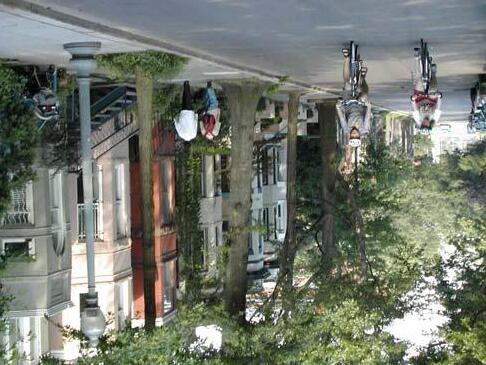
• More walkable areas, including new and existing town centers
• MPCs with greater variety of product and higher connectivity



2008 dollars, adjusted relative to median income growth in Fayette County
OVER HALF OF HOUSEHODS MAKE LESS THAN $50,000 ANNUALLY; HEALTHY DISTRIBUTION IN MIDDLE INCOMES
SOURCE:Claritas, Inc.
NOTE: HH counts do not include those in group quarters

Respondents who indicate interest in living inside New Circle Road
• While the larger majority of respondents are owners, slightly more respondents with interest in living inside New Circle Road are renters.
• Overall, those under 30 have more interest in areas inside NCR as well as those50+,

– Those in ‘family’age groups have more interest in areas outside NCR.
• Single/roommates and couples have more interest in living insideNew Circle Road.
– More families, as indicated by age, prefer areas outside New Circle Road.
• Those with incomes under $69,999 and those above $125,000 have more interest in living inside New Circle Road.
– Those with incomes $70,000 -$124,999 are more interested in areas outside New Circle Road
• Already work with in New Circle Road
– 82% of those with interest inside New Circle Road already work there Most work in Downtown or Central In Town
• Have interest in higher density product types than who with no interest
– 30% have interest in some type of attached product (either for-rent or for-sale)
– 32% have interest in single-family on small lot
• Compared to those with no interest in living inside New Circle Road, those that do have interest in living within New Circle Road indicate a higher demand for homes from $100,000 -$149,999 and then for homes priced $250,000 +
– The bulk of those with interest for inside New Circle Road prefer rents from $600 -$799
Respondents with interest in living inside New Circle Road prefer a more diverse community in terms of people and housing. Overall, respondents who prefer to live outside New Circle Road prefer more conventional community and home themes.
Community:

• 83% want diverse household compositions and ages
• 85% want diverse people in terms of backgrounds, ethnicities andraces
• 58% want people with diverse incomes
• 72% want a community with a variety of housing types and style
Home:
• 71% want homes with smaller square footage and higher finish
• 66% want a home with a less than ideal floorplan but closer to work
• 60% want a less than ideal floorplan but walkable to shops, restaurants, activities
• 66% want homes in more an ‘urban’environment
In terms of community features, respondents who have interest inliving inside New Circle Road are very much driven by walkable features followed by interest in green features and public transportation. Those with no interest in living inside New Circle Road, have very little interest in these community features
Walkable:
• 41% of respondents with interest in living inside New Circle Road think walkable community features are so critical they would pay extra for it
–
12% of respondents with no interest in being inside New Circle Road agree
Green:
• 26% of respondents with interest in living inside New Circle Road think green community features are so critical they would pay extra for it
–

9% of respondents with no interest in being inside New Circle Road agree
Public Transportation:
• 19% of respondents with interest in living inside New Circle Road think public transportation community features are so critical they would payextra for it
– 4% of respondents with no interest in being inside New Circle Road agree


Deficit: Potential out-migrants to surrounding counties In Balance: Overall, market is in balance above $85k
The statistical demand analysis shows a significant gap in available for-sale supply at price levels that are below $85,000
• Land prices within some areas may make single family detached construction in this price band unrealistic
• Consumers will have to make trade offs (e.g. –buying attached product) to stay in Fayette, otherwise they must “drive until they qualify”
Based on historic trends in price appreciations, the $85,000 -$133,000 price band should be monitored for signs of undersupply
1 Source: Fayette County PVA. Based on average of 2004-2007 sales

1 Source: Fayette County PVA. Based on average of 2004-2007 sales

All subareas are undersupplied of for-sale products below $85k.

Generally under-supplied across all price bands. 76% of new product delivered and sold inside New Circle Road since 2004 has been below $270k, revealing that despite rising land prices, it is still possible to deliver products at lower prices at closer-in locations.
North
Of all the sub-areas, appears to have the best supply and demand relationship.
Northwest
Residents showing the least preference for this area, according to consumer research results. However, land availability has meant that Northwest has been the recipient of new supply that has been unable to be delivered in more desirable areas.
South
This area suffers from a dramatic supply/demand imbalance at lower price points.
Southwest Supply/demand imbalance at lower prices points is moving into higher price bands.
East
Similar to the South, suffers a large undersupply of lower priced homes and an oversupply of higher priced homes.
FAYETTE COUNTY ANNUAL STRUCTURAL DEMAND FOR RENTAL PRODUCT
Deficit: Potential out-migrants to surrounding counties
The statistical demand analysis shows a significant undersupply of rental product at the lowest and the highest price bands.
• Apparent pent-up demand for appropriate rental product appealing to mid-and upper-income households who currently “buy down”to lesser product, which amplifies the supply imbalance at lower affordabilities.
• Targeted affordable housing initiatives are likely necessary to help correct the undersupply of rental product at the lowest price bands.
1 Source: 2007 American Community Survey
NOTE: Structural analysis assumes non-student households spend 30% of income on housing


Affordable Housing Trust Fund

Lexington Land Bank -application for Neighborhood Stabilization Program funds for the establishment of a land bank for the purchase of Fayette County foreclosed homes.
Lexington Community Land Trust (CLT) -Under the CLT model, affordability is maintained by separating the ownership of the land from the home. This means the CLT retains ownership of the land while the homebuyer buys and owns the home and the CLT leases the land to the homeowner
• Opportunity for private sector land should be pursued. Universities, hospitals, and other private or quasi-private sector entities have effectively utilized this tool in other markets in order to offer more affordable housing for their employees.
East End Community Development Corporation -primary focus and priority would be to improve the East End and Central Sector Neighborhood holistically
Mixed-use Community Development –integrating a wide range of price points within a well-designed community
Under-utilized properties are key to meeting market
• Opportunities to be redeveloped at a full range of densities.

–
Medium Density Residential (approximately 7,000 total units) is at 4 units to the acre which is slightly lower density than is typically seen with small lot product.
–
High and Very High Density Residential totals approximately 5,000 units (10,000 units shy of market demand)
New mixed-use areas will be required (see map for discussion)
• How to we begin to plan for them now?
• Design according to target market preferences
Redevelopment Steering Committee recommendations (March 2008) point to much of the design characteristics the market seeks.
• Site Design Standards: pedestrian-oriented development.
• Transitional Requirements: create transitional height planes and establish compatibility with surrounding neighborhoods.
• Signage Standards: unified private signage of a common vocabulary

• Streetscape Standards: adequate planting strips, street furnishings, landscape species and hardscapematerials.
• Parks and Open Space Standards: Standards should address locational frequency, public accessibility, and program for new and improved parks and open space.
Administrative allowance for mixed-use
• Form-based approach
• Specific overlays for designated areas, will vary according to area

How is Lexington’s housing market holding up relative to the nation?
• National

• Local
–Lexington Home Sales by the Numbers
–Lexington Rental Market by the Numbers
What share of regional growth has Lexington captured and is expected to capture?
–Fayette and Neighboring Counties
What are the current and future target markets for various housing products in Lexington?
• Demographic Analysis
• Opportunity Assessment
• Submarkets

SOURCE: Case-Shiller Home Price Indices as of fall 2008


TOTAL SALES VOLUMES

Central Kentucky MLS Area 1
1 Contains Bourbon, Clark, Fayette, Jessamine, Madison, Scott, and Woodford counties
SOURCE:Lexington-Bluegrass Association of Realtors

1 Contains Bourbon, Clark, Fayette, Jessamine, Madison, Scott, and Woodford counties
SOURCE:Lexington-Bluegrass Association of Realtors


Fayette Compared to Nation, State, other major college towns
SOURCE:2006 US Census American Community Survey
How is Lexington’s housing market holding up relative to the nation?
• National

• Local
–Lexington Home Sales by the Numbers
–Lexington Rental Market by the Numbers
What share of historical regional growth has Lexington captured and is expected to capture?
–Fayette and Neighboring Counties
What are the current and future target markets for various housing products in Lexington?
• Demographic Analysis
• Opportunity Assessment
• Submarkets

SOURCE:US Census County Business Patterns, Claritas Inc.


SOURCE:US Census, Claritas
Only Jessamine and Scott Counties have more lower income households now than in 2000.




SOURCE:IRS

GROSS DENSITY WITHIN THE URBAN SERVICES AREA IS MUCH GREATER THAN THE SURROUNDING COUNTIES


How is Lexington’s housing market holding up relative to the nation?
• National

• Local
–Lexington Home Sales by the Numbers
–Lexington Rental Market by the Numbers
What share of historical regional growth has Lexington captured and is expected to capture?
–Fayette and Neighboring Counties
What are the current and future target markets for various housing products in Lexington?
• Demographic Analysis
• Opportunity Assessment
• Submarkets
18,760 new county households in 1990s
Average of 1,876 annually Population increased by 35,146
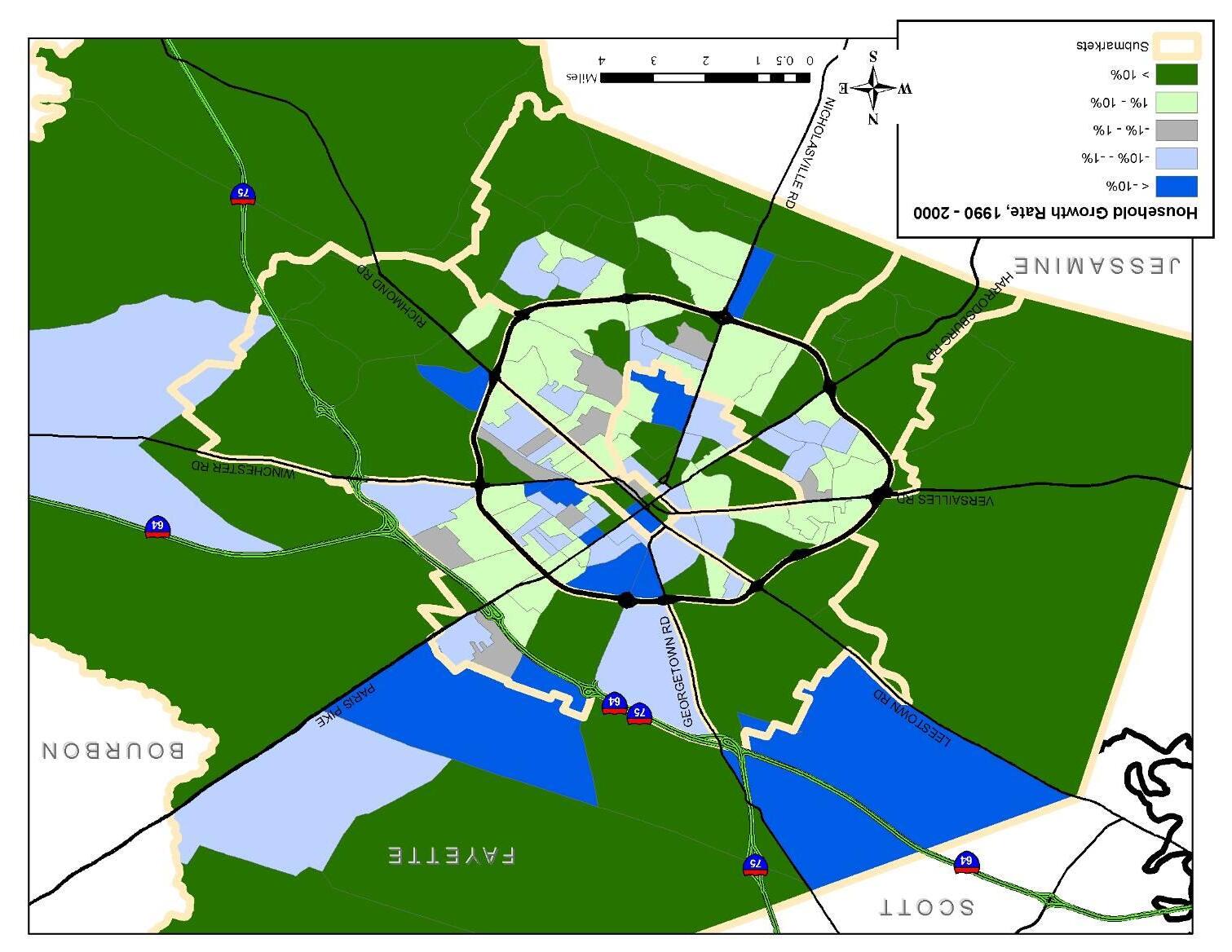

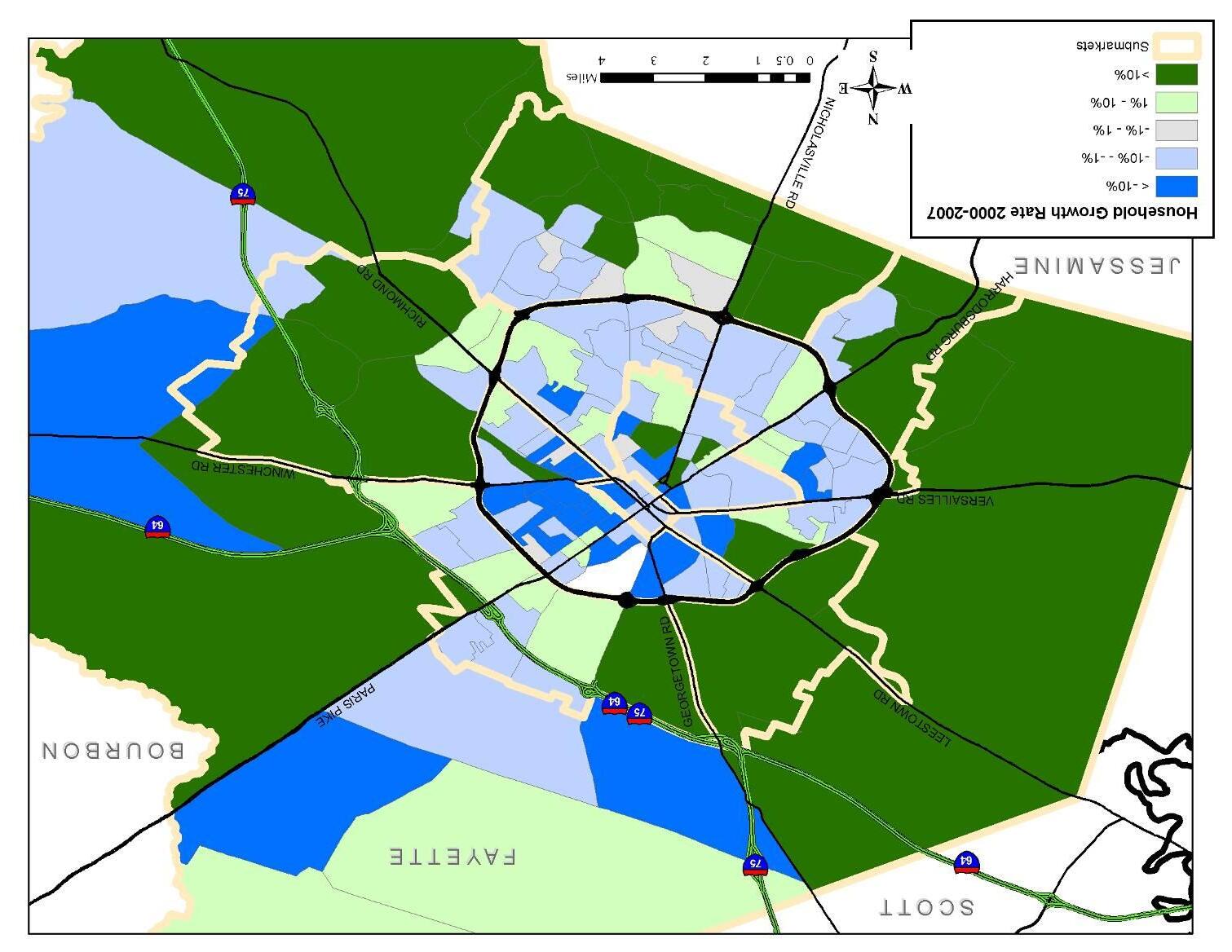
Claritas estimates addition of 944 county households annually Growth roughly half of 1990s
SOURCE: Claritas, Inc.

Claritas projects addition of 803 county households annually Growth nearly 1/3 slower than 1990s Most growth projected to occur in the areas outside New Circle Rd.


Claritas does not take UGB into account.
Therefore, much of this growth may go outside the county
• LFUCG can help identify opportunities to re-direct and retain growth.
SOURCE:Claritas, Inc.
NOTE: HH counts do not include those in group quarters

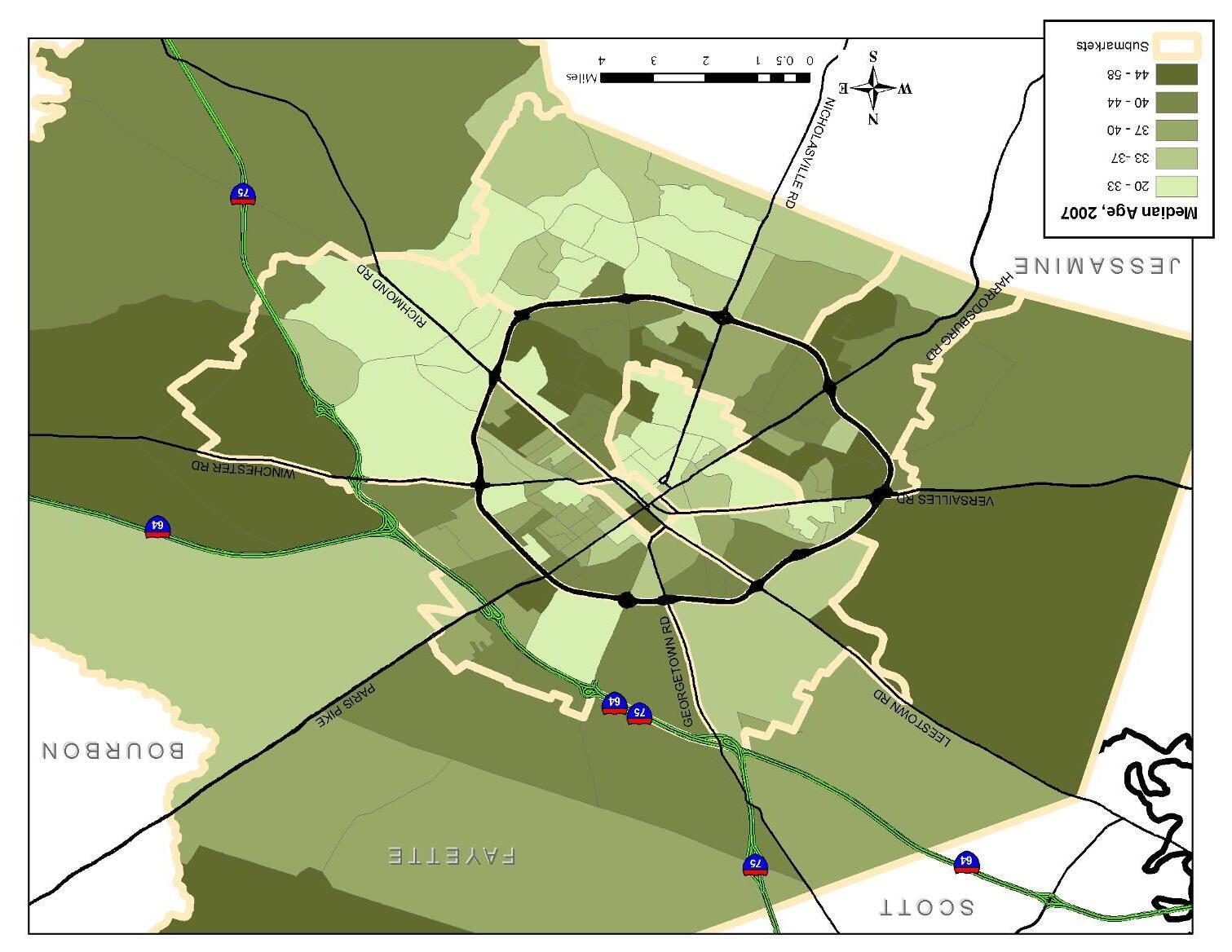
Median age in 2007 was 35.1 years
Up from 33.1 years in 2000
SOURCE: Claritas, Inc.

OVER HALF OF HOUSEHODS MAKE LESS THAN $50,000 ANNUALLY; HEALTHY DISTRIBUTION IN MIDDLE INCOMES
SOURCE:Claritas, Inc.
NOTE: HH counts do not include those in group quarters

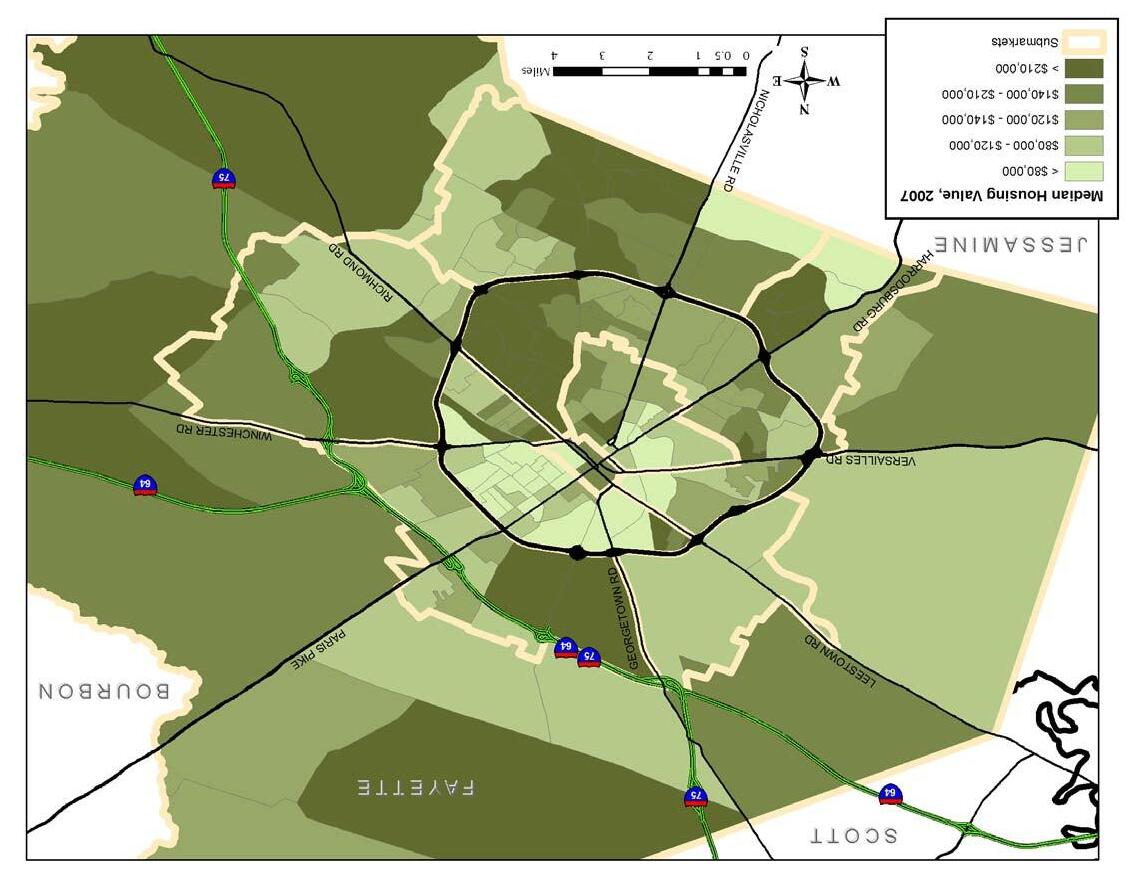
KEY INDICATOR
Median housing value: $144,938


1 and 2 person households made up 67% of households in 2007 Up from 66.1% in 2000
SOURCE: Claritas, Inc.

Statistical Supply/ Demand Analysis.
Consumer Research Results
Consumer Research Participant Demographics and Detailed Answers




1 RCLCO estimate strikes a balance between demonstrated Fayette County housing cost burdens and ideal housing cost burdens to create a figure that is both grounded in actual conditions and recognizes the need toprovide more affordable housing.
% Fayette Owners1
•Income Qualified2
% Fayette Renters1
Annual New Fayette Households
X X X
•Annual turnover rate3
•% choose to buy again
•Income Qualified2
•Annual turnover rate3
•% Renters become owners
•Income Qualified2
•% Owner, Renter HHs

1 Owner and renter propensities are based on Census data for households in Fayette County
2 Income distribution by AMI level is based on Census and Claritas data for households in Fayette County
3 Turnover rates are based on Census data for households in Fayette County
4 Based on RCLCO Consumer Research of Fayette employees
NOTE: This methodology represents structural demand and is intended to act as an average demand for the next five years based onrational market behavior. This demand will not take into account the cyclicality of the housingmarket and should be used as a guide for planning for the mid-term, rather than just the next 12 months.

Would you move outside Fayette County and be farther from work if you were able to pay less for your home?
• 60% said YES
If moving inside New Circle Road lowered my transportation costs, I would:
• Choose a smaller lot: 59% said NO
• Rent: 84% said NO
• Choose attached home: 72% said NO
• Choose a smaller home: 75% said NO
• Pay more: 79% said NO
While Most of the Market is Unwilling to Make Tradeoffs, 15% -40% of the Market is Malleable Enough to be Accommodated in Fayette County.
IF A HOME WAS AVAILABLE THAT FIT YOUR NEEDS, WOULD YOU CONSIDER MOVING TO SUBAREA?
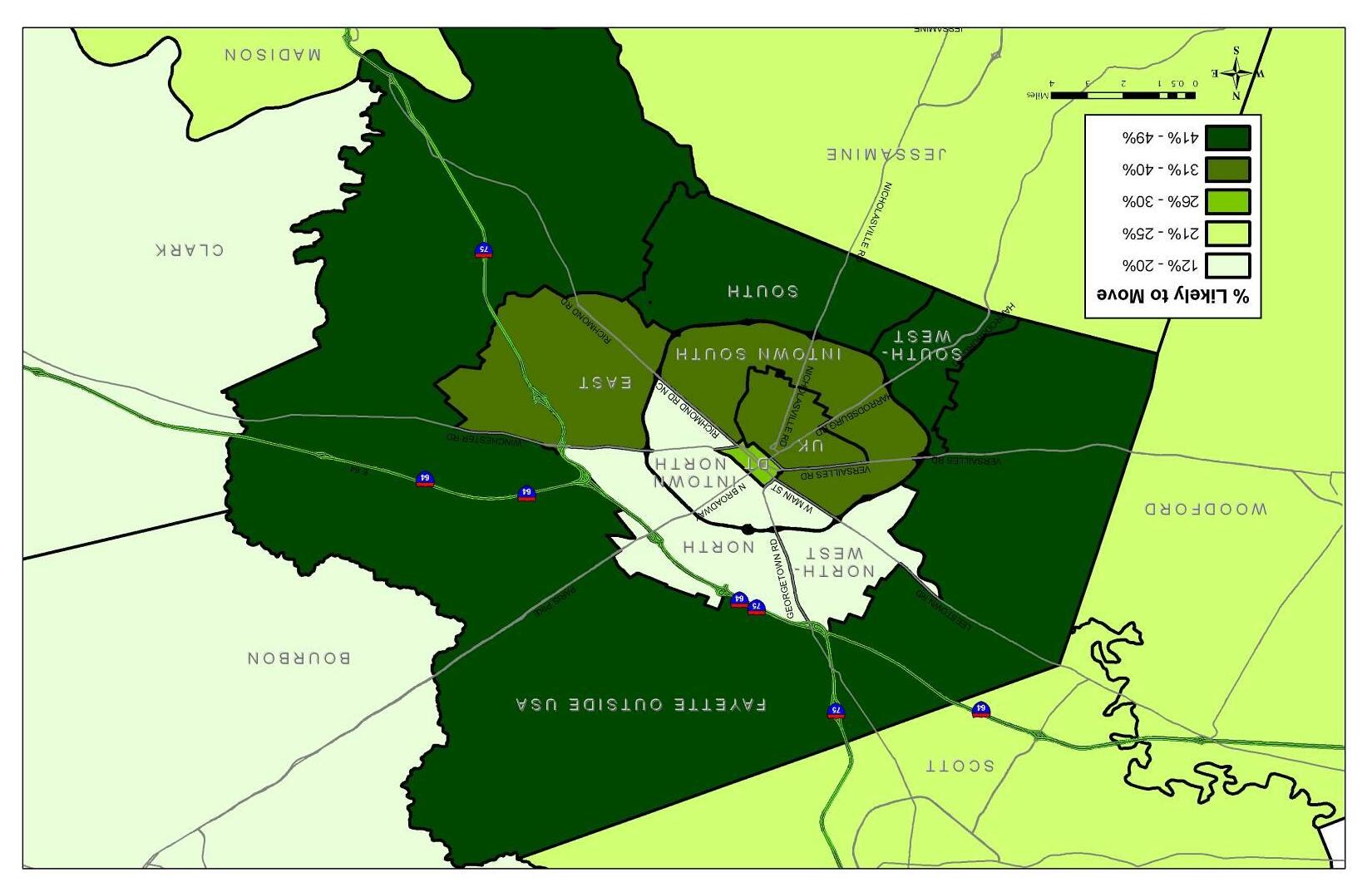
Source: RCLCO consumer research, employee survey

EMPLOYEE SURVEY: WHAT PRODUCT TYPE ARE YOU MOST LIKELY TO CHOOSE?
Small Lot = Less than ¼acres
Medium Lot = ¼to ½acres

Large Lot = ½to 5 acres
Estate Lot = 5+ acres
84.5% SINGLE-FAMILY DETACHED
DETACHED PRODUCT IS THE MOST PREFERRED IN ALL SUBAREAS

EMPLOYEE SURVEY: WHAT PRODUCT TYPE ARE YOU MOST LIKELY TO CHOOSE? AREA MOST LIKELY TO MOVE TO
LARGEST OVERALL DEMAND FOR HOMES ON ¼TO ½ACRE LOTS
OPPORTUNITIES EXIST FOR VARIOUS PRODUCTS ACROSS

Consumer Research Results: Inside New Circle Road Target Markets and Preferences


Survey data indicates that 33% of respondents would move within New Circle Road
• Demand is highest for areas outside New Circle Road
Of those with interest in living within New Circle Road, most would prefer downtown or In town South nodes
Most of the demand comes from those who already live within New Circle Road, however, the respondents indicate that New Circle Road can capture an additional 11% from those currently living outside New Circle Road
Interest in areas inside New Circle Road is largely driven by proximity to work as well as availability to restaurants and green space
• Those who show no interest in living inside New Circle Road indicate this decision is driven by traffic congestion, product type choices and the more urban feel of the area

Preference to move in or outside New Circle Road by area in which they currently live %
Those who live currently live Inside NCR
Those who currently live Outside NCR
Would Move Inside NCR
Those with most interest to live within New Circle Road already live there but 11% of those who don’t currently live within New Circle Road indicate they would move within New Circle Road.
Would Move Outside NCR
SOURCE:RCLCO Consumer Research
89
33% of respondents indicate they would move inside New Circle Road to lower their cost of transportation.
• However, most (79%) will not pay more for a home in order to reduce transportation cost.
Overall, respondents were most interested in making trade-offs in terms of lots size in order to live inside New Circle Road and/or to lower transportation costs
–
33% say they would trade-off lot size to be inside New Circle Road
• Other trade-offs posed were not as popular
–
10% of respondents would choose to rent in order to live inside New Circle Road or to lower transportation costs
–

17% of respondents would choose an attached home in order to live inside New Circle Road, with fewer making this decision in order to reduce transportation costs.
– 75% of respondents indicate they will not trade-off size of home for living inside New Circle Road
78% say they will not choose a smaller home in order to lower transportation cost.
Respondents Who have Interest in living Inside NCR and Why They Do %
Proximity to work
Availability of restaurants
Availability of green space and parks
Consistent look/appearance
Access to sidewalks
Feels more urban
Close to University

Availability of shopping Other
This sub-area has less traffic
Easier/quicker access to the freeway
Feels less urban
SOURCE:RCLCO Consumer Research
Respondents interest in living inside New Circle Road is driven by proximity to work as well as availability of things to do such as, restaurants and green space and parks.
TRAFFIC IS A LARGE DETERRENT FOR THOSE WHO INDICATE THEY WILL NOT MOVE
They Do Not Want to %
Traffic is too congested
Lack of a home in the style I prefer
Feels too dense/urban
Cost of homes too high
Quality of schools
Not walkable enough
Too far from my friends and/or family
Feels to suburban
Not enough quality dining options Other
SOURCE:RCLCO Consumer Research
Respondents who indicate they do not want to live inside New Circle indicate that this decision is driven by:
1)Traffic

2)Home Styles
3)Too much of an Urban Feel
Cost, while the fourth lowest reason also is a factor

SOURCE:American Community Survey




Based on stated desire of unit type from RCLCO consumer research of Lexington students and current demonstrated location preference of students.

PREFERRED GEOGRAPHY FOR RENTAL HOUSING BY SUB-AREA BY PRICE
SUBAREA DOWNTOWN
INTOWN CENTRAL
INTOWN NORTH
INTOWN SOUTH
NORTH

NORTHWEST
SOUTH
SOUTHWEST
EAST
Green box denotes significant demand for rental housing in each price band in a particular sub-area, based on RCLCO direct consumer research.

Conducted an internet based survey
With assistance, approval, and guidance from the steering committee group, RCLCO disseminated survey to employers throughout Lexington via email as well as newspaper articles and advertisements
Survey Respondents were entered in to a raffle for one of two $250 and one of five $100 prizes
N= 901

The error range is +/-3.3%, assuming confidence level of 95%
Average household income: $84,000
Average housing cost: $988/month
57% of respondents are 34-54 years old
84% of respondents are owners
Employer most, 56%, represented is Lexington-Fayette Government
• Those working for ‘Other’are second most represented at 33%
47% of respondents spend 10%-19% of household income on housing
Respondents who indicate interest in living inside New Circle Road
• While the larger majority of respondents are owners, slightly more respondents with interest in living inside New Circle Road are renters.
• Overall, those under 30 have more interest in areas inside NCR as well as those50+,

– Those in ‘family’age groups have more interest in areas outside NCR.
• Single/roommates and couples have more interest in living insideNew Circle Road.
– More families, as indicated by age, prefer areas outside New Circle Road.
• Those with incomes under $69,999 and those above $125,000 have more interest in living inside New Circle Road.
– Those with incomes $70,000 -$124,999 are more interested in areas outside New Circle Road
• Already work with in New Circle Road
– 82% of those with interest inside New Circle Road already work there Most work in Downtown or Central In Town
• Have interest in higher density product types than who with no interest
– 30% have interest in some type of attached product (either for-rent or for-sale)
– 32% have interest in single-family on small lot
• Compared to those with no interest in living inside New Circle Road, those that do have interest in living within New Circle Road indicate a higher demand for homes from $100,000 -$149,999 and then for homes priced $250,000 +
– The bulk of those with interest for inside New Circle Road prefer rents from $600 -$799
Respondents with interest in living inside New Circle Road prefer a more diverse community in terms of people and housing. Overall, respondents who prefer to live outside New Circle Road prefer more conventional community and home themes.
Community:

• 83% want diverse household compositions and ages
• 85% want diverse people in terms of backgrounds, ethnicities andraces
• 58% want people with diverse incomes
• 72% want a community with a variety of housing types and style
Home:
• 71% want homes with smaller square footage and higher finish
• 66% want a home with a less than ideal floorplan but closer to work
• 60% want a less than ideal floorplan but walkable to shops, restaurants, activities
• 66% want homes in more an ‘urban’environment
In terms of community features, respondents who have interest inliving inside New Circle Road are very much driven by walkable features followed by interest in green features and public transportation. Those with no interest in living inside New Circle Road, have very little interest in these community features
Walkable:
• 41% of respondents with interest in living inside New Circle Road think walkable community features are so critical they would pay extra for it
–
12% of respondents with no interest in New Circle Road agree
Green:
• 26% of respondents with interest in living inside New Circle Road think green community features are so critical they would pay extra for it
–
9% of respondents with no interest in New Circle Road agree
Public Transportation:
• 19% of respondents with interest in living inside New Circle Road think public transportation community features are so critical they would payextra for it
–
4% of respondents with no interest in New Circle Road agree

Respondents were asked to ‘design’each node in terms of residential product Looking specifically at respondents who have interest living inside New Circle Road, they felt dense and attached product types were most fitting inside New Circle Road but still indicate demand for single-family homes on smaller lots inside New Circle Road
• Respondents indicated that Downtown and In Town Central should have the most dense product types
High Rise Condo
–
–

40% of respondents think this product type should be in Downtown
18% of respondents think this product type should be in Town Central
Mid Rise Condo
• 26% of respondents think this product type should be in Downtown
• 22% of respondents think this product type should be in Town Central
Residential Above Retail
• 24% of respondents think this product type should be in Downtown
• 18% of respondents think this product type should be in Town Central
Townhomes should be spread out in areas inside and outside of New Circle Road but with more emphasis on inside Garden Apartments should also be inside and outside of New Circle Road but more outside New Circle Road
• 14% of respondents think this product type should be in South
• 14% of respondents think this product type should be in East
• 13%of respondents think this product type should be in North
Single-family homes on smaller lots should be spread out as well but most emphasis on inside New Circle Road
• 14% of respondents think this product type should be in In Town North
• 14%of respondents think this product type should be in In Town South
• 12%of respondents think this product type should be in In Town Central
• 11%of respondents think this product type should be in North
Single-family homes on larger lots should be focused on outside of New Circle Road
• 20% of respondents think this product type should be in South
• 17%of respondents think this product type should be in North
• 17%of respondents think this product type should be in Southwest
• 17%of respondents think this product type should be in East

Overall

SOURCE:RCLCO Consumer Research and US Census

Consumer Research and US Census

Prefer not to say






Under$20,000$20,000$39,999
$40,000-$49,999$50,000-$69,999$70,000-$79,999$80,000-$99,999$100,000-$124,999$125,000ormore
SOURCE:RCLCO Consumer Research















Single-family house on a small lot (less than 1/4 acres)
Single-family house on a medium lot (1/4 to 1/2 acres)
Single-family house on a large lot (1/2 acre to 5 acres)
Single-family house on a very large lot (5+ acres)
Other SOURCE:RCLCO Consumer

Single-family house on a small lot (less than 1/4 acres)
Single-family house on a medium lot (1/4 to 1/2 acres)
Single-family house on a large lot (1/2 acre to 5 acres)
Single-family house on a very large lot (5+ acres)
Other


Of the Inside New Circle nodes, Downtown and In Town South are the most popular


Downtown and In Town South are also most popular for those respondents who indicate that they would want to move within New Circle Road. In town North has significantly less interest overall.
SOURCE:RCLCO
DOWNTOWN AND IN-TOWN SOUTH ARE ALSO MOST POPULAR FOR THOSE WITH INSIDE NCR INTEREST, LEAST INTEREST IS

Respondents Interest in living Inside or Outside NCR by node in which they work % SOURCE:RCLCO
Most of the respondents with interest in living inside New Circle Road already work within New Circle Road, specifically those who work in Downtown and Central In Town.
Only slightly more respondents with interest in living inside New Circle Road are renters, also more respondents with interest in areas outside New Circle Road are owners.


Overall, those under 30 have more interest in areas inside NCR as well as those 50+, those in ‘family’age groups have more interest in areas outside NCR.
SOURCE:RCLCO Consumer Research
Household Composition

SOURCE:RCLCO Consumer Research
Families
Overall, those with incomes under $69,999 and those above $125,000 have more interest in living inside New Circle Road. Those with incomes $70,000 -$124,999 are more interested in areas outside New Circle Road.
Under$20,000

$20,000-$39,999
$40,000-$49,999
$50,000-$69,999
$70,000-$79,999
$80,000-$99,999$100,000-$124,999
$125,000ormore
SOURCE:RCLCO Consumer Research

Overall, respondents who indicate interest in living inside New Circle Road like attached product more than those who prefer to live outside New Circle Road. Further, those with interest also prefer single-family homes on smaller lots much more than those who wish to live outside.
Compared to those with no interest in living inside New Circle Road, those that do have interest in living within New Circle Road indicate a higher demand for homes from $100,000 -$149,999 and then for homes priced $250,000 +. Those with interest in outside New Circle Road seem to represent more of the ‘middle market’.

MOST WITH INTEREST INSIDE NEW CIRCLE ROAD WOULD LIKE TO PAY RENTS $600 -$799 WHERE THOSE WITH NO INTEREST WILL PAY HIGHER RENTS
Respondents Interest in Home Rent Ranges
%

Less than $500 $500 to$599 $600 to $799 $800 + Not Sure
SOURCE:RCLCO Consumer Research
The bulk of those with interest for inside New Circle Road prefer rents from $600 -$799 where as those with no interest inside New Circle Road are willing to pay more in terms of rent.
Interest in NCR No Intrest in NCR
WHILE 33% SAY THEY WOULD MOVE INSIDE NCR TO REDUCE TRANSPORTATION COSTS, MOST WILL NOT PAY MORE
Respondents who would choose to live Inside New Circle Road to lower Transportation costs %
Yes No
Respondents who would pay more for a home to reduce Transportation Costs
%
Yes
12

No
Not sure
10
Not sure
9
33% of respondents indicate they would move inside New Circle Road to lower their cost of transportation. However, most (79%) will not pay more for a home in order to reduce transportation cost.
SOURCE:RCLCO Consumer Research
79
VERY FEW RESPONDENTS WOULD CHOOSE TO RENT IN ORDER TO LIVE INSIDE NEW CIRCLE ROAD
Respondents who would choose to rent to reduce Transportation Costs %
Respondents who would choose to Rent to live Inside New Circle Road % 10 84
Not sure
Yes
No
Not sure
6

Overall, very few respondents would choose to rent in order to live inside New Circle Road or to lower transportation costs. Overwhelming majority would choose to own.
SOURCE:RCLCO Consumer Research
17% OF RESPONDENTS INDICATE THEY WOULD BE WILLING TO CHOOSE ATTACHED TO BE INSIDE NCR
Respondents who would choose to Attached to reduce Transportation Costs %
Respondents who would choose to Attached to live Inside New Circle Road % 15
Yes
No
Not sure
Not sure
13

Slightly more respondents would choose an attached home in orderto live inside New Circle Road, with fewer making this decision in order to reduce transportation costs.
SOURCE:RCLCO Consumer Research
32% OF RESPONDENTS INDICATE THEY WILL CHOOSE A SFD ON A SMALLER LOT TO BE INSIDE NCR

Respondents who would choose a SFD/Small Lot to live Inside NCR % 30 59
Respondents who would choose a SFD/Small Lot to reduce Transportation Costs %
Not sure
Not sure
Interest in trading off lot size to be inside New Circle Road isrelatively large considering other trade-offs. This is the most likely trade-off respondents would make. In addition, 30% would make this trade-off just to save in transportation costs.
SOURCE:RCLCO Consumer Research
RESPONDENTS WILL NOT TRADE-OFF SIZE OF HOME FOR LOCATION INSIDE NCR OR FOR LOWER TRANSPORTATION
Respondents who would choose Smaller Home to live Inside NCR %
Respondents who would choose a smaller home to reduce Transportation Costs %
Yes
No
16 75
Not sure
Not sure
9

The majority of respondents indicate they will not trade-off size of home for living inside New Circle Road or for lowering transportation cost.
SOURCE:RCLCO Consumer Research

A diverse community with people of all ages and household compositions: single people, couples, families and older adults
OR
A community where most residents are similar to your own household composition and age
A community with a diverse mix of people of different racial and ethnic backgrounds
OR
A community where most residents are from the same race or ethnic background

A community where most of the residents have the same or similar incomes
A community with a mix of people from a variety of different incomes
A community with more consistent housing types, styles, and price points throughout
A community that contains a variety of housing types, architectural styles, lot sizes, and price ranges

A community where the emphasis is on a variety of community amenities and activities and less on the actual home
A community where the emphasis is placed on a home, ideal floorplan, and interior space and less so on the community amenities

TRADE-OFF’S HOME THEMES
No Interest in NCR Interest in NCR
52% 29%
OR
A home that is closer to work but a less than ideal home or floorplan OR

A home that is farther to shops and restaurants but the ideal home or floorplan
OR
A home that is closer to shops and restaurants but a less than ideal home or floorplan
A home and a community that met all of your needs and criteria (schools, traffic, safety, etc.) that was in your price range and was in a more "urban" or "intown" environment"
OR
78% 34% A home and a community that met all of your needs and criteria (schools, traffic, safety, etc.) that was in your price range and was in a more “suburban" or "remote" environment

‘A community and home located in a walkable area. For example, an area where you can walk to neighborhood stores, restaurants, schools, dry cleaner, coffee shop, etc ‘

Plays an important to critical role in my home or community selection process
Plays a limited role or no role in my home or community selection process
Plays a critical role; I would be much more likely to buy or rent in a community with this focus and would consider paying more for it
‘A community and home designed to meet certain objectives, such as protecting residents' health; using energy, water, and other resources moreefficiently; and reducing the overall impact on the environment. This type of “green”home and community may cost more initially, but it saves through lower operating costs over the life of the house and by reducing the overall impact on the environment.’
Plays an important to critical role in my home or community selection process

Plays a limited role or no role in my home or community selection process
Plays a critical role; I would be much more likely to buy or rent in a community with this focus and would consider paying more for it
‘A community and home located within close proximity to forms of public transportation. For example, a location where you can walk or have a short drive to a bus stop, train station, metro or subway, etc ‘

Plays an important to critical role in my home or community selection process
Plays a limited role or no role in my home or community selection process
Plays a critical role; I would be much more likely to buy or rent in a community with this focus and would consider paying more for it

Locations Most Appropriate for High Rise Condo by Respondents with Interest in NCR %
None of the above
Locations Most Appropriate for High Rise Condo by Respondents with Interest in NCR %
None of the above
SOURCE:RCLCO Consumer Research

Locations Most Appropriate for High Rise Condo by Respondents with Interest in NCR
None of the above
SOURCE:RCLCO Consumer Research

Locations Most Appropriate for High Rise Condo by Respondents with Interest in NCR
None of the above
SOURCE:RCLCO Consumer Research

None of the above

None of the above SOURCE:RCLCO

Locations Most Appropriate for High Rise Condo by Respondents with Interest in NCR
None of the above
SOURCE:RCLCO Consumer Research
